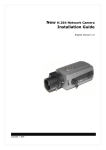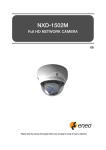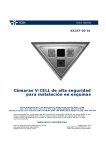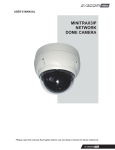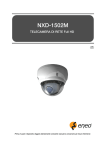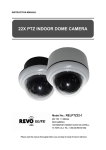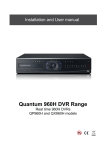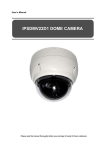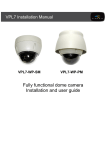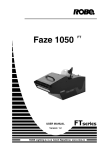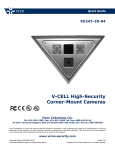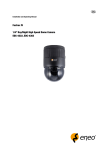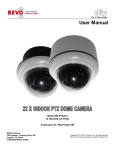Download Instruction Manual
Transcript
Configuration and User manual II VK2-600PTZ User manual WARNING TO REDUCE THE RISK OF FIRE OR ELECTRIC SHOCK, DO NOT EXPOSE THIS PRODUCT TO RAIN OR MOISTURE. DO NOT INSERT ANY METALLIC OBJECTS THROUGH THE VENTILATION GRILLS OR OTHER OPENINGS ON THE EQUIPMENT. CAUTION EXPLANATION OF GRAPHICAL SYMBOLS The lightning flash with arrowhead symbol, within an equilateral triangle, is intended to alert the user to the presence of uninsulated "dangerous voltage" within the product's enclosure that may be of sufficient magnitude to constitute a risk of electric shock to persons. The exclamation point within an equilateral triangle is intended to alert the user to the presence of important operating and maintenance (servicing) instruction in the literature accompanying the product. III VK2-600PTZ User manual CE COMPLIANCE STATEMENT WARNING THIS IS A CLASS A PRODUCT. IN A DOMESTIC ENVIRONMENT THIS PRODUCT MAY CAUSE RADIO INTERFERENCE IN WHICH CASE THE USER MAY BE REQUIRED TO TAKE ADEQUATE MEASURES. IV VK2-600PTZ User manual IMPORTANT SAFETY INSTRUCTIONS 1. Read these instructions. 2. Keep these instructions. 3. Heed all warnings. 4. Follow all instructions. 5. Do not use this apparatus near water. 6. Clean only with dry cloth. 7. Do not block any ventilation openings. Install in accordance with the manufacturer‘s instructions. 8. Do not install near any heat sources such as radiators, heat registers, stoves, or other apparatus (including amplifiers) that produce heat. 9. Do not defeat the safety purpose of the polarized or grounding-type plug. A polarized plug has two blades with one wider than the other. A grounding type plug has two blades and a third grounding prong. The wide blade or the third prong are provided for your safety. If the provided plug does not fit into your outlet, consult an electrician for replacement of the obsolete outlet. 10. Protect the power cord from being walked on or pinched particularly at plugs, convenience receptacles, and the point where they exit from the apparatus. 11. Only use attachments/accessories specified by the manufacturer. 12. Use only with the cart, stand, tripod, bracket, or table specified by the manufacturer, or sold with the apparatus. When a cart is used, use caution when moving the cart/apparatus combination to avoid injury from tip-over. 13. Unplug this apparatus during lightning storms or when unused for long periods of time. 14. Refer all servicing to qualified service personnel. Servicing is required when the apparatus has been damaged in any way, such as power-supply cord or plug is damaged, liquid has been moisture, does not operate normally, or has been dropped. 15. CAUTION – THESE SERVICING INSTRUCTIONS ARE FOR USE BY QUALIFIED SERVICE PERSONNEL ONLY. TO REDUCE THE RISK OF ELECTRIC SHOCK DO NOT PERFORM ANY SERVICING OTHER THAN THAT CONTAINED IN THE OPERATING INSTRUCTIONS UNLESS YOU QRE QUALIFIED TO DO SO. 16. Use satisfy clause 2.5 of IEC60950-1/UL60950-1 or Certified/Listed Class 2 power source only. V VK2-600PTZ User manual Table of Contents Chapter 1 — Introduction........................................................................................................... 1 1.1 Features .............................................................................................................................................1 Chapter 2 — Installation and Configuration ......................................................................... 2 2.1 Package Contents ...........................................................................................................................2 2.2 Installation .........................................................................................................................................3 2.3 Basic Configuration of Dome Camera System ........................................................................5 2.4 Connections ......................................................................................................................................6 2.5 IP Assignment ..................................................................................................................................7 2.6 Getting Started .................................................................................................................................8 Chapter 3 — Operation by Web Browser .............................................................................. 9 3.1 Access from a browser ..................................................................................................................9 3.2 Access from the internet .............................................................................................................10 3.3 Setting the admin password over a secure connection ......................................................10 3.4 Live View Page ...............................................................................................................................10 3.5 Network Camera Setup ................................................................................................................12 3.5.1 Basic Configuration ...............................................................................................................13 1) Users .......................................................................................................................... 13 2) Network ...................................................................................................................... 14 3) Video & Image ........................................................................................................... 15 4) Audio .......................................................................................................................... 17 5) Date & Time ............................................................................................................... 18 3.5.2 Video & Image .........................................................................................................................19 3.5.3 Audio .........................................................................................................................................20 3.5.4 Event ..........................................................................................................................................20 1) Event-In ...................................................................................................................... 20 2) Event-Out ................................................................................................................... 24 3) Event Map .................................................................................................................. 30 3.5.5 System ......................................................................................................................................31 1) Information ................................................................................................................ 31 2) Security ...................................................................................................................... 32 3) Date & Time ............................................................................................................... 35 4) Network ...................................................................................................................... 36 5) Language ................................................................................................................... 43 6) Maintenance .............................................................................................................. 44 7) Support ...................................................................................................................... 45 3.6 PTZ Control .....................................................................................................................................46 VI VK2-600PTZ User manual 3.7 Help ...................................................................................................................................................47 3.8 Resetting to the factory default settings .................................................................................48 3.9 System Requirement for Web Browser ...................................................................................48 Chapter 4 — Program and Operation (RS485 telemetry) ................................................ 49 4.1 How to control the On-Screen Menu ........................................................................................49 4.2 Accessing the On-Screen Menu ................................................................................................49 4.3 Auto Scan ........................................................................................................................................50 4.4 Preset ................................................................................................................................................51 4.5 Quick setting a Preset ..................................................................................................................54 4.6 Tour ...................................................................................................................................................54 4.7 Pattern (Learn Tour) ......................................................................................................................55 4.8 Area Title ..........................................................................................................................................56 4.9 Privacy Zone ..................................................................................................................................57 4.10 Camera Menu................................................................................................................................58 • FOCUS CONTROL ....................................................................................................... 58 • WB (White Balance) CONTROL .................................................................................. 59 • AE CONTROL .............................................................................................................. 59 • DNR CONTROL............................................................................................................ 60 • LINE LOCK CONTROL ................................................................................................ 60 4.11 Dome Setup..................................................................................................................................61 • LANGUAGE SETUP ..................................................................................................... 61 • HOME FUNCTION SETUP ........................................................................................... 61 • OSD DISPLAY .............................................................................................................. 62 • VIEW ANGLE SETUP................................................................................................... 63 • INITIALIZE DATA ......................................................................................................... 64 • ORIGIN OFFSET .......................................................................................................... 65 • DOME RESET .............................................................................................................. 66 • SYSTEM MENU ............................................................................................................ 66 • SYSTEM INFORMATION ............................................................................................. 68 4.12 Factory Setup ...............................................................................................................................68 5 Dome Communication (RS485 Addressing etc) .......................................................................69 Appendix A — Specifications ................................................................................................. 70 Appendix B — Troubleshooting............................................................................................. 73 Appendix C — Glossary ........................................................................................................... 73 VII VK2-600PTZ User manual Chapter 1 — Introduction 1.1 Features Dual video streams simultaneously at full frame rate in all resolutions up to D1 (720X480 in NTSC, 720X576 in PAL) using Motion JPEG and H.264 (or MPEG-4). Built-in 22:1 optical zoom with True Day/Night operation. Intelligent capabilities such as enhanced video motion detection. The encoder‘s external inputs and outputs can be connected to devices such as sensors and relays, enabling the system to react to alarms and activate lights or open/close doors. Supports two-way audio. Logs all user access, and lists currently connected users. Also, full frame rate video can be provided over HTTPS. Interface Protocol: TCP/IP, UDP, IPv4/v6, HTTP, HTTPS, QoS, FTP, SNMP, uPnP, RTP, RTSP, RTCP, DHCP, ARP. 120 Preset positions with the individual Camera AE setup. 4 Tours consist of Presets, Patterns, Auto Scans and other Tours can be programmed with over 150 functions and Preset locations. While moving, each Preset scan can be watched in smooth Vector Scan mode. 4 Auto Scans with the normal, the vector, and the random mode and the Endless Auto-Pan with 13 speed steps. 4 Patterns (up to 200 second) and 4 Privacy Zones. 8 Area Titles. 1 Alarm input / 1 Alarm output (TTL ON/OFF) Variable speed from 0.1 /sec to 380 /sec. Three Variable speed (SLOW, NORMAL, TURBO). Turbo speed is 380 /sec with Ctrl key pressed. Pan / Tilt speed is inversely proportional to the zoom ratio with the option. Maximum speed is 380 /sec when Preset command. Auto Calibration from 0.1 to 6 (Tilt range is 0 to 180 ). Programmable user preferences (alarm, preset, title, etc.). 180 Digital Flip. Up to 255 selectable camera addresses. Multi-language Menu Display, Password Confirmation. Function Run menu using DVR without function key (Pattern, Scan,..) Built-in RS-485 receiver driver. 12VDC or PoE operation. Use a Certified/Listed Class 2 power supply only. 1 VK2-600PTZ User manual Chapter 2 — Installation and Configuration 2.1 Package Contents VK2-600PTZ is design to be a compact, ,vandal resistant dome camera. The housing is constructed of aluminum, steel and plastic. The housing is designed to be mounted both wall and ceiling type. The housing meets the Protection Classification IP66 standards for dust and moisture resistance. * Dome Camera ................................................................1 * Software / Manual CD ...................................................1 * Template sheet ..............................................................1 * Accessory kit .................................................................1 1) Mounting screws (PH6 x 35.0) ..........(4) 2) Plastic anchors ..................................(4) 3) O-Rings .............................................(4) 4) Torx wrench .......................................(1) * Accessory connector ....................................................1 1) 2Pin Terminal Block ...........................(1) 2) 3Pin Terminal Block ...........................(1) 3) 6Pin Terminal Block ...........................(1) 2 VK2-600PTZ User manual 2.2 Installation VK2-600PTZ is for use in surface mounting applications and the mounting surface should be capable of supporting loads up to 3.5lb (1.6kg). VK2-600PTZ‘s base should be attached to a structural object, such as hard wood, wall stud or ceiling rafter that supports the weight of VK2-600PTZ. 3 VK2-600PTZ User manual CAUTION: Before installing the bracket to surface, adjust the four mounting screws "A" on the base of the dome camera to best match the mounting bracket locked position. Unscrew the locking screw on the side of the dome's base and fit the tab of the mounting bracket into the locking slot. Screws "A" should not be too tight or too loose when the dome is in the locked position. After setting the proper positions of screws "A" remove the mounting bracket and install it to the proper surface. If it is too difficult to lock the dome in position after the mounting bracket has been installed readjust the screws "A" by unscrewing them a small amount and try to install dome camera again. 4 VK2-600PTZ User manual 2.3 Basic Configuration of Dome Camera System No. Wire Color Description 1 Red: 12V DC+ White: 12V DC- Main Power: 2pin terminal 2 Pink, Brown Heater Power(Option): 3pin terminal 3 Black: GND Gray: Alarm Input Yellow: GND Black&White: Alarm Output Green: RS485+ Blue: RS485- Alarm Input/Output, RS485: 6pin terminal 4 Black Ethernet: RJ45 Modular Jack 5 Yellow Video Composite Output: BNC Jack 6 Red Audio line output: RCA Jack 7 White Audio line input: RCA Jack VK2-600PTZ must be installed by qualified service personnel in accordance with all local electrical and building codes. 5 VK2-600PTZ User manual 2.4 Connections • Connecting to the RJ-45 Connect a standard RJ-45 cable to the network port of VK2-600PTZ. Generally a cross-over cable is used for directly connection to PC, while a direct cable is used for connection to a hub. • Connecting Alarms AI (Alarm In) You can use external devices to signal VK2-600PTZ to react on events. Mechanical or electrical switches can be wired to the AI (Alarm In) and G (Ground) connectors. See ―4.5.4 Event > 1) Event-In > Alarm In‖ for configuring alarm input. G (Ground) NOTE: All the connectors marked G or GND are common. Connect the ground side of the alarm input and/or alarm output to the G (Ground) connector. AO (Alarm Output) VK2-600PTZ can activate external devices such as buzzers or lights. Connect the device to the AO (Alarm Out) and G (Ground) connectors. See ―4.5.4 Event > 2) Event-Out > Alarm Out‖ for configuring alarm output. • Connecting to the RS485 VK2-600PTZ can be controlled remotely by an external device or control system, such as a control keyboard, using RS485 half-duplex serial communications signals. • Connecting Video out connector Connect the video out (BNC) connector to the monitor or video input. • Connecting the Power Connect the power of DC12V 1.2A for VK2-600PTZ. When using a DC 12V adapter, connector the positive(+) pole to the ‗+‘ position and the negative(-) pole to the ‗-‗ position. Use satisfy clause 2.5 of IEC60950-1/UL60950-1 or Certified/Listed Class 2 power source only. 6 VK2-600PTZ User manual 2.5 IP Assignment When VK2-600PTZ, encoder or decoder is first connected to the network it has no IP address. So, it is necessary to allocate an IP address to the device with the ―SmartManager‖ utility on the CD. 1. Connect VK2-600PTZ / device to the network and power up. 2. Start SmartManager utility (All programs > NautilusClient16 > SmartManager), the main window will be displayed, after a short while any network devices connected to the network will be displayed in the list. 3. Select VK2-600PTZ on the list and click right button of the mouse. You can see the pop-up menu as below. 4. Select Assign IP Address. You can see Assign IP window. Enter the required IP address. Note: For more information, refer to the Smart Manger User‘s Manual. 7 VK2-600PTZ User manual 2.6 Getting Started Once installed apply power to VK2-600PTZ. It will start a configuration sequence. PRESET TITLE AREA TITLE FUNCTION UNDER RUNNING 001 AF AE CAMERA TITLE EMPTY DATA INFORMATION DISPLAY CAMERA ID DOMEID:0001 W→360.0,090.0 ALARM:1 ALARM DISPLAY PAN & TILT ANGLE VIEW DIRECTION OSD Position The dome can move the OSD position in the OSD position setup. (AREA TITLE) (FUNC TITLE ) (AF AE) (CTRL KEY TO MOVE) SAVE AND EXIT(ESC TO CANCEL) (ALARM MESSAGE) (DOME ID…) (ANGLE…) OSD Position Setup 8 VK2-600PTZ User manual STATUS of FOCUS and AE Chapter 3 — Operation by Web Browser The VK2-600PTZ can be used with Windows operating system and browsers. The recommended browsers are Internet Explorer, Safari, Firefox, Opera and Google Chrome with Windows. Note: To view streaming video in Microsoft Internet Explorer, set your browser to allow ActiveX controls. 3.1 Access from a browser 1) Start a browser (Internet Explorer). 2) Enter the IP address or host name of the network camera in the Location/Address field of your browser. 3) You can see a starting page. Click Live View or Setup to enter web page. 4) The encoder‘s Live View page appears in your browser. 9 VK2-600PTZ User manual 3.2 Access from the internet Access from the internet once connected, the network camera is accessible on your local network (LAN). To access the video encoder from the Internet you must configure your broadband router to allow incoming data traffic to the video encoder. To do this, enable the NAT traversal feature, which will attempt to automatically configure the router to allow access to the video encoder. This is enabled from Setup > System > Network > NAT. For more information, please see NAT traversal (port mapping) for IPv4, on ―4.5.5 System > 4) Network > NAT traversal‖. 3.3 Setting the admin password over a secure connection To gain access to the product, the password for the default administrator user must be set. This is done in the ―Admin Password‖ dialog, which is displayed when the network camera is accessed for the setup at the first time. Enter your admin name and password, set by the administrator. Note: The default administrator username and password is ―admin‖. If the password is lost, the network camera must be reset to the factory default settings. See ―4.8 Resetting to the factory default settings‖ for more details. To prevent network eavesdropping when setting the admin password, this can be done via an encrypted HTTPS connection, which requires an HTTPS certificate (see note below). To set the password via a standard HTTP connection, enter it directly in the first dialog shown below. To set the password via an encrypted HTTPS connection, see Setup > System > Security > HTTPS, on ―4.5.5 System > 2) Security > HTTPS‖. Note: HTTPS (Hypertext Transfer Protocol over SSL) is a protocol used to encrypt the traffic between web browsers and servers. The HTTPS certificate controls the encrypted exchange of information. 3.4 Live View Page The live view page comes in seven screen modes like 704x576(480), 704x288(240), 352x288(240), 176x144(120), 640x480, 320x240 and 160x120. Users are allowed to select the most suitable one out of those modes. Please, adjust the mode in accordance with your PC specifications and monitoring purposes. 10 VK2-600PTZ User manual 1) General controls The video drop-down list allows you to select a customized or preprogrammed video stream on the live view page. Stream profiles are configured under Setup > Basic Configuration > Video & Image. See ―4.5.1 Basic Configuration‖ for more information. The resolution drop-down list allows you to select the most suitable one out of video resolutions to be displayed on live view page. The protocol drop-down list allows you to select which combination of protocols and methods to use depends on your viewing requirements, and on the properties of your network. The preset drop-down list allows you to select the preset number for the PTZ camera being used. This icon is inactivated if the PTZ settings are not set. 2) Control toolbar The live viewer toolbar is available in the web browser page only. It displays the following buttons: The Stop button stops the video stream being played. Pressing the key again toggles the start and stop. The Start button connects to the network camera or start playing a video stream. The Pause button pause the video stream being played. The Snapshot button takes a snapshot of the current image. The location where the image is saved can be specified. The digital zoom activates a zoom-in or zoom-out function for video image on the live screen. The Full Screen button causes the video image to fill the entire screen area. No other windows will be visible. Press the 'Esc' button on the computer keyboard to cancel full screen view. The Manual Trigger button activates a pop-up window to manually start or stop the event. 11 VK2-600PTZ User manual The Camera Menu button activates a pop-up window for camera menu control. The PTZ button activates a pop-up window for Pan, Tilt and Zoom control. Use this scale to control the volume of the speakers. Use this scale to control the volume of the microphone. Use this scale to control the volume of the speakers and microphones. 3) Camera Menu controls If the network camera has been appropriately configured, the Live View page displays the controls available for the OSD menu. For more information, please see ―Chapter 3 — Program and Operation‖. 4) Pan/Tilt/Zoom controls If the network camera has been appropriately configured, the Live View page displays the controls available for the PTZ (Pan Tilt Zoom) or PT device installed. The administrator can enable/disable the controls for specified users. Please see ―4.6 PTZ Control‖ for more information. 5) Video and Audio Streams The network camera provides several images and video stream formats. Your requirements and the properties of your network will determine the type you use. The Live View page in the network camera provides access to H.264, MPEG-4 and Motion JPEG video streams, and to the list of available video streams. Other applications and clients can also access these video streams/images directly, without going via the Live View page. 3.5 Network Camera Setup This section describes how to configure the network camera, and is intended for product Administrators, who have unrestricted access to all the Setup tools; and Operators, who have access to the settings for Basic, Live View, Video & Image, Audio, Event, and System Configuration. You can configure the network camera by clicking Setup in the top right-hand corner of the Live View page. Click on this page to access the online help that explains the setup tools. 12 VK2-600PTZ User manual When accessing the network camera for the first time, the ―Admin Password‖ dialog appears. Enter your admin name and password, set by the administrator. Note: If the password is lost, the network camera must be reset to the factory default settings. See ―4.8 Resetting to the Factory Default Settings‖. 3.5.1 Basic Configuration 1) Users User access control is enabled by default. An administrator can set up other users, by giving these user names and passwords. It is also possible to allow anonymous viewer login, which means that anybody may access the Live View page, as described below: The user list displays the authorized users and user groups (levels): User Group Authority Guest Provides the lowest level of access, which only allows access to the Live View page. Operator An operator can view the Live View page, create and modify events, and adjust certain other settings. Operators have no access to System Options. Administrator An administrator has unrestricted access to the Setup tools and can determine the registration of all other users. Enable anonymous viewer login: Check the box to use the webcasting features. Refer to ―4.5.2 Video & Image‖ for more details. 13 VK2-600PTZ User manual 2) Network The network camera support both IP version 4 and IP version 6. Both versions may be enabled simultaneously, and at least one version must always be enabled. When using IPv4, the IP address for the video encoder can be set automatically via DHCP, or a static IP address can be set manually. If IPv6 is enabled, the video encoders receive an IP address according to the configuration in the network router. There is also the option of using the Internet Dynamic DNS Service. For more information on setting the network, please see Setup > System > Network, on ―4.5.5 System > 4) Network‖. • Obtain IP address via DHCP: Dynamic Host Configuration Protocol (DHCP) is a protocol that lets network administrators centrally manage and automate the assignment of IP addresses on a network. DHCP is enabled by default. Although a DHCP server is mostly used to set an IP address dynamically, it is also possible to use it to set a static, known IP address for a particular MAC address. • Use the following IP address: To use a static IP address for the network camera, check the radio button and then make the following settings: - IP address - Specify a unique IP address for your network camera. - Subnet mask - Specify the mask for the subnet the network camera is located on. - Default router - Specify the IP address of the default router (gateway) used for connecting devices attached to different networks and network segments. Notes: 1. DHCP should only be enabled if using dynamic IP address notification, or if your DHCP server can update a DNS server, which then allows you to access the network camera by name (host name). If DHCP is enabled and you cannot access the unit, you may have to reset it to the factory default settings and then perform the installation again. 2. The ARP/Ping service is automatically disabled two minutes after the unit is started, or as soon as an IP address is set. 3. Pinging the unit is still possible when this service is disabled. 14 VK2-600PTZ User manual 3) Video & Image • Video Setting: - Codec: The codec settings are separated into MPEG4 and H.264. H.264 is also known as MPEG-4 Part 10. This is the new generation compression standard for digital video. This function offers higher video resolution than Motion JPEG or MPEG-4 at the same bit rate and bandwidth, or the same quality video at a lower bit rate. - Profile: There are 4 pre-programmed stream profiles available for quick set-up. Choose the form of video encoding you wish to use from the drop-down list: * H.264 MP(Main Profile): Primarily for low-cost applications that requires additional error robustness, this profile is used rarely in videoconferencing and mobile applications, it does add additional error resilience tools to the Constrained Baseline Profile. The importance of this profile is fading after the Constrained Baseline Profile has been defined. * H.264 BP(Base Profile): Originally intended as the mainstream consumer profile for broadcast and storage applications, the importance of this profile faded when the High profile was developed for those applications. * MPEG4 SP(Simple Profile): Mostly aimed for use in situations where low bit rate and low resolution are mandated by other conditions of the applications, like network bandwidth, device size etc. * MPEG4 ASP(Advanced Simple Profile): Its notable technical features relative to the Simple Profile, which is roughly similar to H.263, including "MPEG"-style quantization, interlaced video, B pictures (also known as B Frames), Quarter Pixel motion compensation (Qpel), Global motion compensation (GMC). - Resolution: It enables users to determine a basic screen size when having an access through the Web Browser or PC program. The screen size control comes in seven modes like 4CIF(704x576(480)), 2CIF(704x288(240)), CIF(352x288(240)), QCIF(176x144(120)), VGA(640x480), QVGA(320x240), and QQVGA(160x120). Users can reset the selected screen size anytime while monitoring the screen on a real-time basis. 15 VK2-600PTZ User manual - Bitrate control: Limiting the maximum bit rate helps control the bandwidth used by the H.264 or MPEG-4 video stream. Leaving the Maximum bit rate as unlimited maintains consistently good image quality but increases bandwidth usage when there is more activity in the image. Limiting the bit rate to a defined value prevents excessive bandwidth usage, but images are lost when the limit is exceeded. Note that the maximum bit rate can be used for both variable and constant bit rates. The bit rate can be set as Variable Bit Rate (VBR) or Constant Bit Rate (CBR). VBR adjusts the bit rate according to the image complexity, using up bandwidth for increased activity in the image, and less for lower activity in the monitored area. CBR allows you to set a fixed target bitrate that consumes a predictable amount of bandwidth. As the bit rate would usually need to increase for increased image activity, but in this case cannot, the frame rate and image quality are affected negatively. To partly compensate for this, it is possible to prioritize either the frame rate or the image quality whenever the bit rate needs to be increased. Not setting a priority means the frame rate and image quality are equally affected. - Compression: When it is necessary to adjust a smooth transmission status according to network situations, users can increase the compressibility to carry out the network transmission stably. On the other hand, when it is necessary to maintain a detailed monitoring screen by enhancing the image quality, users can do so by decreasing the compressibility. In ease case, please adjust this function according to the network status and monitoring purposes. The default is 2000(Kbps). - Frame rate: Upon the real-time play, users should select a frame refresh rate per second. If the rate is high, the image will become smooth. On the other hand, if the rate is low, the image will not be natural but it can reduce a network load. - GOP size: Select the GOP(Group of Picture) size. If users want to have a high quality of fast image one by one, please decrease the value. For the purpose of general monitoring, please do not change a basic value. Such act may cause a problem to the system performance. For the details of GOP setting, please contact the service center. • Image Setting: Sometimes the image size is large due to low light or complex scenery. Adjusting the frame rate and quality helps to control the bandwidth and storage used by the Motion JPEG video stream in these situations. Limiting the frame rate and quality optimizes bandwidth and storage usage, but may give poor image quality. To prevent increased bandwidth and storage usage, the Resolution, Frame rate, and Frame Quality should be set to an optimal value. - JPEG resolution: Same as the video settings. - JPEG frame rate: Same as the video settings. - JPEG quality: Select the picture quality. If users want to have a high quality of fast image one by one, please decrease the value. For the purpose of general monitoring, please do not change a basic value. Such act may cause a problem to the system performance. When satisfied with the settings, click Save, or click Reset to revert to previously saved settings. 16 VK2-600PTZ User manual 4) Audio The network camera can transmit audio to other clients using an external microphone and can play audio received from other clients by attaching a speaker. The Setup page has an additional menu item called Audio, which allows different audio configurations, such as, full duplex, and simplex. • Audio Setting: - Enable audio: Check the box to enable audio in the video stream. - Compression type: Select the desired audio Compression format, G726. - Sample rate: Select the required Sample rate (number of times per second the sound is sampled). The higher the sample rate, the better the audio quality and the greater the bandwidth required. - Sound bitrate: Depending on the selected encoding, set the desired audio quality (bitrate). The settings affect the available bandwidth and the required audio quality. • Audio Input: Audio from an external line source can be connected to the RCA Jack I/O of the network camera. - Input volume: If there are problems with the sound input being too low or high, it is possible to adjust the input gain for the microphone attached to the network camera. • Audio Output: - Enable full duplex: Check the box to enable Full Duplex mode. It means that you can transmit and receive audio (talk and listen) at the same time, without having to use any of the controls. This is just like having a telephone conversation. This mode requires that the client PC has a sound card with support for full-duplex audio. Uncheck the box enable Simplex mode. The simplex mode only transmits audio from the network camera to any web client. It does not receive audio from other web clients. 17 VK2-600PTZ User manual - Output volume: If the sound from the speaker is too low or high it is possible to adjust the output gain for the active speaker attached to the network camera. When satisfied with the settings, click Save, or click Reset to revert to previously saved settings. 5) Date & Time • Current Server Time: It displays the current date and time (24h clock). The time can be displayed in 12h clock format in the overlay (see below). • New Server Time: Select your time zone from the drop-down list. If you want the server clock to automatically adjust for daylight savings time, select the ―Automatically adjustment for daylight saving time changes‖. From the Time Mode section, select the preferred method to use for setting the time: - Synchronize with computer time: sets the time from the clock on your computer. - Synchronize with NTP Server: the video encoder will obtain the time from an NTP server every 60 minutes. - Set manually: this option allows you to manually set the time and date. 18 VK2-600PTZ User manual 3.5.2 Video & Image 1) Basic Refer to ―4.5.1 Basic Configuration > 3) Video & Image‖ for more details. 2) Webcasting – Channel1 The network camera can stream live video to a website. Copy the HTML code generated on the screen and paste it in page code of the website you want to display live video. Note: To use webcasting service, the Enable Anonymous viewer login option must be checked. Refer to ―3.5.1 Basic Configuration > 1) Users‖ for more details. 19 VK2-600PTZ User manual 3.5.3 Audio Refer to ―3.5.1 Basic Configuration > 4) Audio‖ for more details. 3.5.4 Event 1) Event-In On Boot This is used to trigger the event every time the Network Transmitter is started. Select ―Enable‖ to activate the motion event. 20 VK2-600PTZ User manual Alarm In Select ―Enable‖ to activate the alarm event. The network camera support 1 alarm input ports. - Type: Choose the type of alarm you wish to use from the drop-down list. - Dwell Time: Set the dwell time an event lasts for the specified dwell time from the point of detection of an alarm input. Manual Trigger 21 VK2-600PTZ User manual This option makes use of the manual trigger button provided on the live view page, which are used to start or stop the event type manually. Alternatively the event can be triggered via the product's API (Application Programming Interface). Motion Motion detection is used to generate an alarm whenever movement occurs (or stops) in the video image. A total of 8 Motion and/or Mask windows can be created and configured. Motion is detected in defined Motion windows, which are placed in the video image to target specific areas. Movement in the areas outside the motion windows will be ignored. If part of a motion window needs to be masked, this can be configured in a Mask window. • Pre-Viewer: Motion detection windows are configured by Motion or Mask windows. Each window can be selected by clicking with the mouse. It is also possible to resize or delete, or move the window, by selecting the appropriate window at the mouse menu on the video screen. To create a motion or mask window, follow steps: 1. Click the right button of mouse to see the mouse menu. 2. Select New Motion (or Mask) Window in the mouse menu. 22 VK2-600PTZ User manual 3. Click and drag mouse to designate a motion area. • Motion Detection Setting: The behavior for each window is defined by adjusting the Threshold and Sensitivity, as described below. A motion index is a set of parameters describing Window Name, Type, Threshold, Sensitivity, and Dwell Time. Window Types is one of Motion and Mask windows. - Threshold: Sets up the sensitivity for the motion detection. - Sensitivity: Sets up the sensitivity for the motion detection. - Dwell Time: Set the hold time an event lasts for the specified hold time from the point of detection of a motion. You can also modify or delete a motion index. Select an index and then, click the Modify or Delete button. Select ―Enable‖ to activate the motion window. Network Loss This is used to trigger the event every time the network connection is failed. Select ―Enable‖ to activate the Network Loss event. 23 VK2-600PTZ User manual 2) Event-Out SMTP(E-Mail) The network camera can be configured to send event and error email messages via SMTP (Simple Mail Transfer Protocol). • SMTP(E-Mail) Setting: Select ―Enable‖ to activate the SMTP operation. - Mail Server / Port: Enter the host names (or IP addresses) and port numbers for your mail server in the fields provided, to enable the sending of notifications and image email messages from the camera to predefined addresses via SMTP. - Sender: Enter the email address to be used as the sender for all messages sent by the Network Transmitter. - Interval: Represents the frequency of the email notification when an event occurs. - Aggregate events: Shows the maximum number of emails sent within each interval. If your mail server requires authentication, check the box for Use authentication to log in to this server and enter the necessary information. - User Name / Password: Enter the User Name and Password as provided by your network administrator or ISP (Internet Service Provider). To ensure that the login procedure is performed as securely as possible when using SMTP authentication, you must define the weakest authentication method allowed. - Login Method: Set the Weakest method allowed to the highest/safest method supported by the mail server. The most secure method is listed in the drop-down list: Login / Plain 24 VK2-600PTZ User manual • SMTP(E-Mail) Receiver: - Receiver: Enter an email address. You can also register the e-mail address of recipients up to 8. • SMTP(E-Mail) Test: - Receiver: Enter an email address and click the Test button to test that the mail servers are functioning and that the email address is valid. FTP & JPEG When the network camera detects an event, it can record and saves images to an FTP server. Images can be sent as e-mail attachments. Check the box to enable the service. • FTP Setting - Server: Enter the server's IP address or host name. Note that a DNS server must be specified in the TCP/IP network settings if using a host name. - Port: Enter the port number used by the FTP server. The default is 21. - Use passive mode: Under normal circumstances the network camera simply requests the target FTP server to open the data connection. Checking this box issues a PASV command to the FTP server and establishes a passive FTP connection; whereby the network camera actively initiates both the FTP control and data connections to the target server. This is normally desirable if there is a firewall between the camera and the target FTP server. - Remote directory: Specify the path to the directory where the uploaded images will be stored. If this directory does not already exist on the FTP server, there will be an error message when uploading. - User name / Password: Provide your log-in information. • JPEG Setting: 25 VK2-600PTZ User manual - Pre-event: A pre-event buffer contains images from the time immediately preceding the event trigger. These are stored internally in the server. This buffer can be very useful when checking to see what happened to cause the event trigger. Check the box to enable the pre-trigger buffer, enter the desired total length in seconds, minutes or hours, and specify the required image frequency. - Post-event: This function is the counterpart to the pre-trigger buffer described above and contains images from the time immediately after the trigger. Configure as for preevent. - Prefix file name: This name will be used for all the image files saved. If suffixes are also used, the file name will take the form <prefix>,<suffix>,<extension>. - Additional suffix: Add either a date/time suffix or, a sequence number - with or without a maximum value. HTTP Server When the network camera detects an event, HTTP Server is used to receive uploaded image files and/or notification messages. Check the box to enable the service. • HTTP Server Setting: - Name: The name of the HTTP event server. Use a descriptive name. - URL: The network address to the server and the script that will handle the request. For example: http://192.168.12.244/cgi-bin/upload.cgi - User name/Password: Provide your log-in information. • HTTP Server Test: When the setup is complete, the connection can be tested by clicking the Test button. 26 VK2-600PTZ User manual Alarm Out When the network camera detects an event, it can control external equipment connected to its alarm output port. Check the box to enable and then select either: - Enable: When you select ―Enable alarm out‖, the output will be activated for as long as the event is active. Audio Alert When the network camera detects an event, it can output a predefined audio data to external speaker. Check the box to enable the service. 27 VK2-600PTZ User manual • Audio Alert Setting: To use the audio alert with the Network Transmitter, an audio data file made by user must be uploaded from your PC. Provide the path to the file directly, or use the Browse button to locate it. Then click the Upload button. An audio file for Audio Alert can be made by Audio Recorder tool in the NautilusClient16 software. • Audio Alert Test: When the setup is complete, the audio output can be tested by clicking the Test button. To remove an audio file, select index and click the Remove button. Note: For a proper operation of Audio Alert, you must enable ―full duplex‖ in Audio setting page. Audio Recorder To use Audio Recorder tool to make an audio file for Audio Alert function, you must install the NautilusClient16 on the installation CD at first. The NautilusClient16 program (All Programs > NautilusClient16 > NautilusClient16) in your PC, the main window will be displayed as below. Click ―Tool‖ in the menu of the main window and select Audio Recorder to start Audio Recorder. Audio Recorder window will be appeared. The description of each button in the ARecorder window follows. 28 VK2-600PTZ User manual Open: Open an audio file. Capture: Capture audio from the microphone in your PC. Save: Save a captured file to your PC. (PCM format) Encode: Encode a current capture file or opened PCM file to G.726 file for Audio Alert. Play: Play a current audio file. Stop: Stop playing audio. Procedures to make an audio file in G.726 format for Audio Alert. 1. Connect the microphone in your PC. 2. Click the Capture button and talk to the microphone to record the audio or voice. You can record up to 30 seconds. Click the Stop button to stop on capturing. 3. Click the Save button and then set the file name to save a current capture file with PCM format. If you don‘t need to make any PCM file, skip this step and then go to the step 5 directly. 4. Click the Open button and then select the file name to open an audio file in PCM format. 5. Click the Encode button to encode a current audio file to G.726 format for Audio Alert. Set the file name and encode parameters. Caution: All parameters must be synchronized with ones in audio setting page of network devices for a proper operation. 29 VK2-600PTZ User manual PTZ Preset When the Network Transmitter detects an event, you can make a PTZ camera connected to its RS485 port to move to a predefined preset position. Check the box to enable the service and return to the Home position once the event has ended. 3) Event Map The event map allows you to change the settings and establish a schedule for each event trigger from the network camera. You can register the event map up to max. 15. Click Add button to make a new event map and you can see a popup window as below. 30 VK2-600PTZ User manual • General: Enter the name for a new event map. • Event In: Select an event type in the drop down list. • Event Out: - E-mail: Select email addresses you want to send via email that an event has occurred. - FTP: Select checkbox beside FTP to record and saves images to an FTP server when an event has occurred. - HTTP Server: It sends notification messages to an HTTP server that listens for these. The destination server must first be configured on the Event In page. Enter a message you want to send. - Audio Alert: Select a Audio alert file the Network Transmitter output when audio alert event triggered. The Audio alert file must first be configured on the Event In page. 3.5.5 System 1) Information You can enter the system information. This page is very useful when you refer device information after installation. 31 VK2-600PTZ User manual • Device Name Configuration: Enter the device name. • Location Configuration: Enter the location information. You can enter that by four. 2) Security Users User access control is enabled by default, when the administrator sets the root password on first access. New users are authorized with user names and passwords, or the administrator can choose to allow anonymous viewer login to the Live View page, as described below: • User Setting: 32 VK2-600PTZ User manual Check the box to enable anonymous viewer login to the network camera without the user account. When using the user account, users have to try log-in at every access. • User List Setting: This section shows a registered user account. Enter a user name and password to be added, and register them by pressing the Add button. You can see the pop-up window as below. HTTPS For greater security, the network camera can be configured to use HTTPS (Hypertext Transfer Protocol over SSL (Secure Socket Layer)). That is, all communication that would otherwise go via HTTP will instead go via an encrypted HTTPS connection. • HTTPS Connection Policy: 33 VK2-600PTZ User manual Choose the form of connection you wish to use from the drop-down list for the administrator, Operator and Viewer to enable HTTPS connection (set to HTTP by default). - HTTP - HTTPS - HTTP & HTTPS • Upload Certificate: To use HTTPS for communication with the network camera, An official certificate issued by a CA (Certificate Authority) must be uploaded from your PC. Provide the path to the certificate directly, or use the Browse button to locate it. Then click the Upload button. Please refer to the home page of your preferred CA for information on where to send the request. For more information, please see the online help. IP Filtering Checking the Enable IP address filtering box enables the IP address filtering function. Up to 256 IP address entries may be specified (a single entry can contain multiple IP addresses). Click the Add button to add new filtered addresses. When the IP address filter is enabled, addresses added to the list are set as allowed or denied addresses. All other IP addresses not in this list will then be allowed or denied access accordingly, that is, if the addresses in the list are allowed, then all others are denied access, and vice versa. See also the online help for more information. Note that users from IP addresses that will be allowed must also be registered with the appropriate access rights (Guest, Operator or Administrator). This is done from Setup > System > Security > Users, on ―4.5.5 System > 2) Security > Users‖. 34 VK2-600PTZ User manual 3) Date & Time • Current Server Time: It displays the current date and time (24h clock). The time can be displayed in 12h clock format in the overlay (see below). • New Server Time: Select your time zone from the drop-down list. If you want the server clock to automatically adjust for daylight savings time, select ―Automatically adjustment for daylight saving time changes‖. From the Time Mode section, select the preferred method to use for setting the time: - Synchronize with computer time: sets the time from the clock on your computer. - Synchronize with NTP Server: the video encoder will obtain the time from an NTP server every 60 minutes. - Set manually: this option allows you to manually set the time and date. Note: Note that if using a host name for the NTP server, a DNS server must be configured under TCP/IP settings. 35 VK2-600PTZ User manual 4) Network Setting in regard to network can be executed. Settings for IP, DNS, Host Name, Port, and ARP/Ping can be established, along with setting for DDNS, uPnP, QoS, and SNMP. Basic • IP Address Configuration: - Obtain IP address via DHCP: Dynamic Host Configuration Protocol (DHCP) is a protocol that lets network administrators centrally manage and automate the assignment of IP addresses on a network. DHCP is enabled by default. Although a DHCP server is mostly used to set an IP address dynamically, it is also possible to use it to set a static, known IP address for a particular MAC address. - Use the following IP address: To use a static IP address for the network camera, check the radio button and then make the following settings: * IP address: Specify a unique IP address for your network camera. * Subnet mask: Specify the mask for the subnet the network camera is located on. * Default router: Specify the IP address of the default router (gateway) used for connecting devices attached to different networks and network segments. 36 VK2-600PTZ User manual • IPv6 Address Configuration: Check this box to enable IPv6. Other settings for IPv6 are configured in the network router. • DNS Configuration: DNS (Domain Name Service) provides the translation of host names to IP addresses on your network. - Obtain DNS Server via DHCP: Automatically use the DNS server settings provided by the DHCP server. Click the View button to see the current settings. - Use the following DNS server address to enter the desired DNS server by specifying the following: * Domain name: enter the domain(s) to search for the host name used by the network camera. Multiple domains can be separated by semicolons (;). The host name is always the first part of a Fully Qualified Domain Name, for example, myserver is the host name in the Fully Qualified Domain Name myserver.mycompany.com where mycompany.com is the Domain name. * DNS servers: enter the IP addresses of the primary and secondary DNS servers. • Host Name Configuration: - Host Name: enter the host name to be used as device information in the client software or SmartManager. • Services: - HTTP port: Enter a port to receive a service through the HTTP. Default Port Number is ‗80‘. - RTSP port: Enter a port to receive a service through the RTSP. Default Port Number is ‗7070‘. - PTZ port: Enter a port to control the Pan/Tilt/Zoom. Default Port Number is ‗7000‘. • ARP/Ping Setting: - Enable ARP/Ping setting of IP address: The IP address can be set using the ARP/Ping method, which associates the unit's MAC address with an IP address. Check this box to enable the service. Leave disabled to prevent unintentional resetting of the IP address. 37 VK2-600PTZ User manual DDNS • Internet DDNS(Dynamic Domain Name Service): When using the high-speed Internet with the telephone or cable network, users can operate the network camera even on the floating IP environment in which IPs are changed at every access. Users should receive an account and password by visiting a DDNS service like http://www.dyndns.com/ or http://www.cctv-network.co.kr/. - Enable DDNS: Check to get DDNS service to be available. * DDNS Server: Select the DDNS server. * Registered host: Enter an address of the DDNS server. * Username: Enter an ID to access to the DDNS server. * Password: Enter a password to be used for accessing the DDNS server. * Confirm: Enter a password again to confirm it. * Maximum time interval: Set a time interval to synchronize with the DDNS server. Select an item in the interval drop-down list. * Register local network IP address: Register a Network Video Server IP address to the DDNS server. 38 VK2-600PTZ User manual RTP Have a setting for sending and receiving an audio or video on a real-time basis. These settings are the IP address, port number, and Time-To-Live value to use for the media stream(s) in multicast H.264 format. Only certain IP addresses and port numbers should be used for multicast streams. For more information, please see the online help. • Port Range: - Start port: Enter a value between 1024 and 65532. • Multicast: This function is for sending Video and Audio to Multicast group. - Enable Multicast: Check the box to enable multicast operation. - Multicast destination IP: Enter an IP between 224.0.0.0 and 239.255.255.255. Although it is empty, an IP will be entered automatically. - RTP port: Enter a value between 1024 and 65532. - RTP TTL: Enter a value between 1 and 255. If a network status is smooth, enter a lower value. On the other hand, if a network status is poor, enter a higher value. When there are many network cameras or users, a higher value may cause a heavy load to the network. For a detailed setting, please consult with a network manager. 39 VK2-600PTZ User manual UPnP The network camera includes support for UPnP™. UPnP™ is enabled by default, and the network camera then is automatically detected by operating systems and clients that support this protocol. Note: UPnP™ must be installed on your workstation if running Windows XP. To do this, open the Control Panel from the Start Menu and select Add/Remove Programs. Select Add/Remove Windows Components and open the Networking Services section. Click Details and then select UPnP™ as the service to add. 40 VK2-600PTZ User manual QoS Quality of Service (QoS) provides the means to guarantee a certain level of a specified resource to selected traffic on a network. Quality can be defined as a maintained level of bandwidth, low latency, and no packet losses. The main benefits of a QoS-aware network are: - The ability to prioritize traffic and thus allow critical flows to be served before flows with lesser priority. - Greater reliability in the network, thanks to the control of the amount of bandwidth an application may use, and thus control over bandwidth races between applications. • DSCP Settings: For each type of network traffic supported by your network video product, enter a DSCP (Differentiated Services Code Point) value. This value is used to mark the traffic‘s IP header. When the marked traffic reaches a network router or switch, the DSCP value in the IP header tells the router or switch which type of treatment to apply to this type of traffic, for example, how much bandwidth to reserve for it. Note that DSCP values can be entered in decimal or hex form, but saved values are always shown in decimal. The following types of traffic are marked: - Live Stream DSCP: - Event/Alarm DSCP: - Management DSCP: • Auto Traffic Control: Set a limitation on user network resources by designating the maximum bandwidth. 41 VK2-600PTZ User manual - Maximum bandwidth: In case of sharing other network programs or equipment, it is possible to set a limitation on the maximum bandwidth in the unit of Mbit/s or kbit/s. - Auto frame rate: Selected if not influenced by a network-related program or equipment without a limitation on the network bandwidth. NAT Traversal A broadband router allows devices on a private network (LAN) to share a single connection to the Internet. This is done by forwarding network traffic from the private network to the ―outside‖, that is, the Internet. Security on the private network (LAN) is increased since most broadband routers are pre-configured to stop attempts to access the private network (LAN) from the public network/Internet. Use NAT Traversal when your network cameras are located on an intranet (LAN) and you wish to make it available from the other (WAN) side of a NAT router. With NAT traversal properly configured, all HTTP traffic to an external HTTP port in the NAT router is forwarded to the network camera. Notes: - For NAT traversal to work, this must be supported by the broadband router. - The broadband router has many different names: ―NAT router‖, ―Network router―, ―Internet Gateway‖, ―Broadband sharing device‖ or ―Home firewall‖ but the essential purpose of the device is the same. 42 VK2-600PTZ User manual • NAT traversal Settings: - Enable: when enabled, the Network Transmitters attempt to configure port mapping in a NAT router on your network, using UPnP™. Note that UPnP™ must be enabled in the network camera (see Setup > System > Network > UPnP, on ―4.5.5 System > 4) Network > UPnP‖). * automatic setting: The network camera automatically search for NAT routers on your network. * manual setting: Select this option to manually select a NAT router and enter the external port number for the router in the field provided. Notes: - If you attempt to manually enter a port that is already in use, an alert message will be displayed. - When the port is selected automatically it is displayed in this field. To change this enter a new port number and click Save. 5) Language It will be able to select a user language. The type of language it will be able to select is the English, the French, the German, the Spanish and the Italian. 43 VK2-600PTZ User manual 6) Maintenance • Maintenance Server: - Restart: The unit is restarted without changing any of the settings. Use this method if the unit is not behaving as expected. - Restore: The unit is restarted and most current settings are reset to factory default values. The settings that are not affected are: - the boot protocol (DHCP or static) - the static IP address - the default router - the subnet mask - the system time - Default: The default button should be used with caution. Pressing this will return all of the network camera's settings to the factory default values (including the IP address). • Update Server: Carry out the upgrade by importing an upgrade file and pressing the Upgrade button. During the upgrade, do not turn off the power of the network camera. And try an access again after waiting five minutes or longer. • Backup: Save a setting value that users enter to the network camera, to a user PC. • Restore: Import and apply a setting value saved to a user PC. Note: Backup and Restore can only be used on the same unit running the same firmware. This feature is not intended for multi-configurations or for firmware upgrades. 44 VK2-600PTZ User manual 7) Support The support page provides valuable information on troubleshooting and contact information, should you require technical assistance. • Logs: The network camera support system log information. Click the System Log button to get the log data. • Update Server: - Server Report: Click the Server Report button to get the important information about the server‘s status and should always be included when requesting support. - Parameter List – Click the Parameter List button to see the unit‘s parameters and their current settings. 45 VK2-600PTZ User manual 3.6 PTZ Control You can control a PTZ in the live screen. Press the activate the PTZ control panel. PTZ Control Panel PTZ Menu Panel button on the left top in the live screen to Direction Buttons Iris/Focus/Zoom Buttons • Control Panel: - Left/Right button: Go into the sub-menu items. Execute the command (exit). Change value. Navigate through the menu items. - Up/Down button: Navigate through the menu items - PAN/TILT Speed: It sets a speed when adjusting the PTZ Camera. The higher a value is, the faster a speed will be. 46 VK2-600PTZ User manual - Focus: Overrides auto focus. Moving the Zoom handle reactivates Auto Focus mode. - Iris: Overrides auto iris. Moving the joystick reactivates Auto Iris mode. - Zoom: Zoom control. • Menu Panel: - Menu: Enters programming menu. - Esc: Cancels current inputs. Exits from currently running functions or menu, error status, etc. - Home: Immediately calls Home function. Deletes selected value or function in programming mode. - Ctrl Off: Control function. ex) CTRL + Up, Down, Right, Left Button > Operated turbo mode. - Preset: Pressing the Preset will bring up the preset programming menu. - Auto Scan: Pressing the Scan will bring up the Auto Scan programming menu. - Tour: Pressing the Tour button will bring up the tour programming menu directly. - Pattern: Pressing the Pattern button will bring up the pattern programming menu directly. 3.7 Help The Help information window will be provided as a popup window so that users can open and read it without a need for log-in. It will offer a description on setting and Help page by which users can manipulate the network camera without a reference to the manual. 47 VK2-600PTZ User manual 3.8 Resetting to the factory default settings To reset the network camera to the original factory settings, go to the Setup > System > Maintenance web page or use the control button on the network camera, as described below: • Using the Reset Button Follow the instructions below to reset the network camera to the factory default settings using the Reset Button. 1. Switch off the network camera by disconnecting the power adapter. 2. Open the lens cover. 3. Press and hold the Control Button (SW1) on the board with your finger while reconnecting the power. 4. Keep the Control button (SW1) pressed during about 2 seconds. 5. Release the Control Button (SW1). 6. The network camera resets to factory defaults and restarts after completing the factory reset. 7. Close the lens cover. CAUTION: When performing a Factory Reset, you will lose any settings you have saved. 3.9 System Requirement for Web Browser Operating System: Microsoft Windows 98, Microsoft Windows ME, Microsoft Windows 2000, Microsoft Windows XP, or Microsoft Windows Vista CPU: Over Pentium IV 2.4Ghz, 512MB RAM, 10GB free disk or higher VGA: AGP, Video RAM 32MB or higher (1024x768, 24bpp or higher) 48 VK2-600PTZ User manual Chapter 4 — Program and Operation (RS485 telemetry) 4.1 How to control the On-Screen Menu Please be aware that whilst the commands in BOLD in the table below are generic for most keyboards, DVR‘s and popular protocols, if you are not using a Vista controller and Protocol then you may need to refer to the user manual for that controlling device to generate the required command. In any sub menu whereby ‗CTRL‘ is displayed onscreen and the (IO/FN) command is selected the screen the Joystick has full PTZ control of the camera. Function Action required / Button Press Command Open the On-Screen Menu Camera Menu Command Joystick Up, Down, Left, Right Moving the cursor Navigate through the menu. Joystick Up or Down Go into the sub-menu items. Joystick right or IRIS Open/FOCUS Near Keys (IO/FN) Changing values Enter the editing title mode. To enter the changing angle mode (e.g. presets, privacy etc). To exit the changing angle mode (e.g. presets, privacy etc) EXIT or Back a Step in the Menu Joystick left / right or Zoom via Joystick (Tele/Wide) IRIS Open/Focus Near (IO/FN) IRIS Close/Focus Far (IC/FF) Joystick left or IRIS Close/Focus Far (IC/FF) 4.2 Accessing the On-Screen Menu Once the configuration sequence has finished, you can call up the On-screen menu of the dome by entering the Dome menu: E.g. push and hold the CAMERA key and push MODE once on a VKBD4. This will bring up a password request screen. As default the Password for the dome is switched ON and to proceed to the main set up screen use the Joystick to move the cursor over the required character and select with the key push of (IO/FN). NOTE: The default password for the dome is: 5,5,5,5,5,5 - you are now in the the VPL6 menu and the following screen is displayed: 49 VK2-600PTZ User manual DOME MENU AUTO SCAN PRESET TOUR PATTERN AREA TITLE PRIVACY ZONE CAMERA DOME SETUP DOME COMMUNICATION EXIT (ESC TO EXIT) 4.3 Auto Scan Allows the Dome to be set up to move automatically between 2 programmed locations, the Auto Scan can be recalled from the controlling device using the AUX6 command. AUTO SCAN SETUP NUMBER : 01 TITLE : A01 MODE : NORMAL SPEED : 5 STEP START ANGLE : ----- ----END ANGLE : ----- ----SCAN DIR : CCW SWAP : OFF DWELL : 03 SEC SAVE AND EXIT(ESC TO CANCEL) NUMBER : 01 (cannot be changed – only 1no Autoscan is available). TITLE : Up to 12 characters. MODE : NORMAL, VECTOR, RANDOM. NORMAL : Moves from the start point to end point using only pan. VECTOR : Moves from the start point to end point linearly applying pan, tilt and zoom. RANDOM : Moves randomly between the start angle and the end angle. SPEED : 01~13 steps, the lowest number means the slowest speed. START ANGLE : The 1st set of digits relates to the pan position, the 2nd set of digits relates to the tilt position. END ANGLE : The 1st set of digits relates to the pan position, the 2nd set of digits relates to the tilt position. SCAN DIR : Set the Scan direction, CCW (Counter Clock Wise), CW (Clock Wise). SWAP : Swaps the start angle for the end angle. DWELL : Sets the dwell time at the start & end points, between 01~99 seconds. Follow steps below to set up the Auto Scan: 1. TITLE – this can be changed one of two ways: Moving the Joystick left and right to select the cursor location and (TELE/WIDE) to change the character. 50 VK2-600PTZ User manual Use the Joystick to move and navigate the cursor to the alpha numeric character table displayed and select the required character with the (IO/FN) keys. TITLE EDIT MENU A01 * A B C D E F G H I J K L M N O P Q R S T U V W X Y Z 0 1 2 3 4 5 6 7 8 9 ( ) ALL DELETE EXIT(ESC TO EXIT) 2. Select ‗MODE‘ - adjust with (TELE/WIDE) 3. Select ‗SPEED‘ - adjust with (TELE/WIDE) 4. ‗START ANGLE‘ Use the Joystick to move cursor to START ANGLE Press the (IO/FN) key ‗CTRL‘ is displayed. Move the camera to the desired location and the zoom position. Press the (IC/FF) and ‗CTRL‘ disappears. and START ANGLE is now set. To fine tune the Pan and Tilt position use Joystick to move the cursor to the field you wish to change and twist the Joystick to adjust the position in increments of 0.1 degree. 5. ‗END ANGLE‘ Use the Joystick to move cursor to END ANGLE. Press the (IO/FN) key ‗CTRL‘ is displayed. Move the camera to the desired location and the zoom position. Press the (IC/FF) and ‗CTRL‘ disappears and END ANGLE is now set. To fine tune the Pan and Tilt position use the Joystick to move the cursor to the field you wish to change and twist the Joystick to adjust the position in increments of 0.1 degree. 6. Select ‗SCAN DIR‘ to CCW or CW – adjust with (TELE/WIDE) 7. Select ‗SWAP‘. Set to ON, to swap the start angle and the end angle - adjust with (TELE/WIDE) 8. Select ‗DWELL TIME‘ - adjust with (TELE/WIDE) 9. To save changes highlight ‗SAVE AND EXIT‘ and move Joystick right. Joystick left exits without saving. 4.4 Preset Up to 120 presets may be programmed. Presets can be recalled No. + PRESET. Presets on the VPL6 are very powerful and allow you to set the camera parameters and even a motion alarm for each preset. There are two pages of Preset menu. Each page has 60 Presets. The pages can be scrolled by moving the Joystick to the left or right on the first or last No. of Preset on the line. 51 VK2-600PTZ User manual PRESET SETUP NUMBER : 001 TITLE : --CAMERA SET DWELL : --- SEC 12345678901234567890 00 █**----------------02 -------------------04 -------------------NEXT PAGE SAVE AND EXIT(ESC TO CANCEL) - : a blank Preset position * : the position has a Preset already assigned █ : the current cursor position NOTE: Whilst the ‗NUMBER‘ field at the top of this screen is adjustable, it does not update/auto populate the preset position lower down on the screen. So when setting up a preset position always use the lower part beneath ‗DWELL‘ for this. Follow steps below to store the Preset positions: 1. Use the Joystick to move the cursor to the preset position you wish to add/adjust. 2. After selecting a preset position (blank or already populated), press the (IO/FN) key ‗CTRL‘ is displayed. Move to the desired location and zoom position then press the (IC/FF) key then ‗CTRL‘ disappears. The Preset for this location is then set. 3. Select ‗TITLE‘ – this can be changed one of two ways: Moving the Joystick left and right to select the cursor location and (TELE/WIDE) to change the character Use the Joystick to move and navigate the cursor to the alpha numeric character table displayed and select the required character with the (IO/FN) keys. 4. Select ‗CAMERA SET‘ and move Joystick to the right. Then the Preset camera setup displays. PRESET CAMERA SETUP FOCUS : AUTO MOTION : OFF MOTION SETUP AE SETUP SAVE AND EXIT(ESC TO CANCEL) Set ‗FOCUS‘ Set ‗MOTION‘ : AUTO, MANUAL, ONE PUSH – adjust with (TELE/ZOOM) : OFF, ON – adjust with (TELE/ZOOM) Select ‗MOTION SETUP‘ and move the Joystick to the right, the ‗MOTION SETUP‘ menu is displayed. 52 VK2-600PTZ User manual MOTION SETUP SENSITIVITY : 07 POSITION : ALL DELAY : 00 SEC OUTPUT : OFF HOLD TIME : 03 SEC EXIT(ESC TO EXIT) Set SENSITIVITY Set POSITION Set DELAY Set OUTPUT Set HOLD TIME : 01~10 – adjust with (TELE/ZOOM) : ALL, CENTER – adjust with (TELE/ZOOM) : 0~5 SEC – adjust with (TELE/ZOOM) : OFF, ON – adjust with (TELE/ZOOM) : 03~99 SEC – adjust with (TELE/ZOOM) Select ‗AE SETUP‘ and move the Joystick to the right, the AE setup menu is displayed. AE SETUP MODE : MANUAL SLOW SHUTTER : --GAIN : MIN BRIGHT : 003 SHUTTER : 1/50 FLICKERLESS : --BACK LIGHT : OFF WDR : --WDR LEVEL : --D/N MODE : AUTO SAVE AND EXIT(ESC TO CANCEL) MODE AE1 / AE2 / SHUTTER PRIO / MANUAL AE1 AE2 SHUTTER PRIO MANUAL SLOW SHUTTER GAIN BRIGHT SHUTTER FLICKERLESS BACK LIGHT WDR WDR LEVEL D/N MODE Auto exposure mode1 (Set for normal surroundings: e.g. indoor) Auto exposure mode2 (Set for high brightness surroundings: e.g. outdoor) Variable Shutter speed, Auto Gain Variable Shutter speed, Gain ON / OFF MIN / LOW / MID / HIGH 0~70 in steps of 1 1/50, 1/120, 1/250, 1/500, 1/1000, 1/2000, 1/10000, 1/100000 ON / OFF ON / OFF (NOTE: When ON, WDR will be disabled) ON / OFF (NOTE: When ON, BACKLIGHT will be disabled) 10~50 in steps of 1 AUTO / B/W / COLOUR NOTE: The WDR function operates in AE1 mode only. The D/N mode option removes the IR cut filter of the camera and makes the camera sensitive to near infrared. AUTO B/W COLOUR Camera goes into monochrome mode at low light (determined by the GAIN setting) Permanent monochrome mode Permanent colour mode 53 VK2-600PTZ User manual NOTE: The ‗AUTO‘ setting in D/N mode function does not operate when ‗MANUAL‘ mode is selected in AE Control. 6. Set ‗DWELL TIME‘ (03~99 seconds in steps of 1) - adjust with (TELE/WIDE) 7. To select the next page of Presets, scroll the page by moving the Joystick to the left or right on the first and last columns of the menu. 8. Repeat step 2 through 7 for each additional Preset position. 9. To save changes highlight ‗SAVE AND EXIT‘ and move Joystick right. Joystick left exits without saving. 4.5 Quick setting a Preset This can be achieved after selecting the desired scene e.g. with VKBD4 by pressing FUNCTION (Fn) then the No. (1 to 120) then PRESET key sequentially. The current view will be stored to the selected Preset number. If the Preset number is not empty, an ‗OVER WRITE‘ message will be displayed on the screen and select to ‗OK‘ or ‗Cancel‘ as required and move the Joystick to the right to confirm. Example: FN, 1, 0, 1, PRESET keys will store current view as Preset no. 101. In this case, focus will be programmed as Auto, dwell time will be set to 3 second, and the current AE mode will be programmed. NOTE: If the password is set to ON within the Dome then this will need to be entered to accept the new or amended Preset change. 4.6 Tour There are 4 programmable Tours. Each Tour consists of up to 42 Preset positions, Patterns, Scan or other Tours (second-level). Using second-level Tours, a Tour can be expanded to over 150 functions in a single Tour. Tours can be recalled No. + TOUR. TOUR SETUP NUMBER : 01 TITLE : T01 SCAN TYPE : NORMAL SPEED : 5 STEP DWELL : -- SEC 003 A01 --- --- --- --- ----- --- --- --- --- --- ----- --- P01 --- --- --- ----- T02 --- --- --- --- ----- --- --- --- --- --- ----- --- --- --- --- --- --SAVE AND EXIT(ESC TO CANCEL) --SCAN TYPE DWELL 003 VK2-600PTZ User manual : Blank position : NORMAL, VECTOR : 03~99 SEC : Preset (1~120) 54 A01 P01 T02 : Auto Scan (1) : Pattern (1~4) : Tour (1~4) Follow the steps below to program the Tours: 1. Select ‗NUMBER‘ and set the desired number by moving the Joystick to the left or right. 2. Choose a blank position to be programmed by moving the Joystick up, down, right, or left. 3. To scroll to a stored Preset , adjust with (TELE/WIDE) then the stored Preset number displays. 4. To select functions other than Preset, press the (IO/FN) key to scroll for Tour, Pattern or Auto Scan respectively (if you wish to remove a Preset or Function from a Tour keep pushing (IO/FN) until ‗---‗ is displayed in the position). 5. Repeat step 1 through 4 for each desired position. Each title (if programmed) will be displayed on top of the line. 6. Select ‗TITLE‘ – this can be changed one of two ways: Moving the Joystick left and right to select the cursor location and (TELE/WIDE) to change the character Use the Joystick to move and navigate the cursor to the alpha numeric character table displayed and select the required character with the (IO/FN) keys. 7. To save changes highlight ‗SAVE AND EXIT‘ and move Joystick right. Joystick left exits without saving. You can expand the Tour sequence by inserting another Tour into one of the ‗---‗ positions just a as you would a Preset. NOTES: You cannot allocate a Preset or Function into a Tour without it being programmed first. The speed applies in the Vector mode only. If you require the picture to ‗freeze‘ between presets, this can be found in the cameras set-up menu. 4.7 Pattern (Learn Tour) The Pattern feature records up to a total of 200seconds of user control. Up to 4 Patterns can be stored, inserted into a Tour and played back by pressing the No. + Learn keys sequentially. PATTERN SETUP (CTRL KEY) NO TITLE SEC PERCENT 01 : P01 000 00.0% 02 : P02 000 00.0% 03 : P03 000 00.0% 04 : P04 000 00.0% TOTAL 000 00.0% SAVE AND EXIT(ESC TO CANCEL) Follow steps below to program the Pattern: 1. Select the desired Pattern to be programmed by moving the Joystick up or down. If the Pattern is not 000, a Pattern has already been recorded. Patterns can be overwritten. 55 VK2-600PTZ User manual 2. Press the (IO/FN) key then the ‗CTRL‘ displays. Move the Dome through the required field of view applying zoom if required - the Dome movement will be automatically recorded. Press the (IC/FF) key then ‗CTRL‘ disappears. 3. To save changes highlight ‗SAVE AND EXIT‘ and move Joystick right. Joystick left exits without saving. 4. Select ‗TITLE‘ – this can be changed one of two ways: Moving the Joystick left and right to select the cursor location and (TELE/WIDE) to change the character Use the Joystick to move and navigate the cursor to the alpha numeric character table displayed and select the required character with the (IO/FN) keys. NOTE: The 200 seconds can be used per Pattern. Each movement uses memory to store the change – the % column show show much of the total pattern memory has been used for each tour and also gives the running total at the bottom. The Pattern memory does not have to be evenly distributed across all of the Patterns. 4.8 Area Title Enter a specific name on a programmed angle between START and END. E.g. For the screen below, when the camera points at an angle between 124.3 (PAN), 30.7 (TILT) to 359.5 (PAN), 45.4 (TILT), ABC will be displayed on the screen. AREA TITLE SETUP NUMBER : 01 TITLE : ABC START ANGLE : 124.3 30.7 END ANGLE : 359.5 45.4 SWAP : OFF SAVE AND EXIT(ESC TO CANCEL) NUMBER TITLE SWAP : 01-08 : up to 12 characters. : Swap the start point for the end point. Follow steps below to program the Area Title: 1. Select ‗NUMBER‘ and set the desired number by moving the Joystick to the left or right. 2. Select ‗TITLE‘ – this can be changed one of two ways: Moving the Joystick left and right to select the cursor location and (TELE/WIDE) to change the character Use the Joystick to move and navigate the cursor to the alpha numeric character table displayed and select the required character with the (IO/FN) keys. 3. Select ‗START ANGLE‘. Press the (IO/FN) key, then ‗CTRL‘ is displayed. Move to the desired position. Press the (IC/FF) key then ‗CTRL‘ disappears. To adjust at the 0.1 degree interval, twist the Joystick at the pan field and the tilt field. 56 VK2-600PTZ User manual 4. Select ‗END ANGLE‘. Press the (IO/FN) key, then ‗CTRL‘ is displayed. Move to the desired position. Press the (IC/FF) key then ‗CTRL‘ disappears. To adjust at the 0.1 degree interval, twist the Joystick at the pan field and the tilt field. 5. Select ‗SWAP‘. Set to ON, to swap the start angle and the end angle - adjust adjust with (TELE/WIDE) 6. To save changes highlight ‗SAVE AND EXIT‘ and move Joystick right. Joystick left exits without saving. 4.9 Privacy Zone There are 4no Privacy Zones available. NO 01 02 03 04 PRIVACY ZONE SETUP (CTRL KEY) TITLE METHOD ABC ON BLOCK DEF ON BLOCK OFF ---OFF ---- SAVE AND EXIT(ESC TO CANCEL) NUMBER TITLE METHOD : 01-04 : up to 12 characters. : Block Follow steps below to program the Privacy Zone: 1. Select ‗TITLE‘ – this can be changed one of two ways: Moving the Joystick left and right to select the cursor location and (TELE/WIDE) to change the character Use the Joystick to move and navigate the cursor to the alpha numeric character table displayed and select the required character with the (IO/FN) keys. 2. Select the Privacy Zone you wish to set using the Joystick to highlight location. Press the (IO/FN) key, ‗CTRL‘ is displayed and Privacy Area Menu displays. Move to the desired position. Press the (IC/FF) key then ‗CTRL‘ disappears and returns to the previous menu. NOTE: The Privacy Zone is set up to the actual screen size and NOT the Privacy Area ‗targeting‘ display on the screen. PRIVACY AREA MENU (CTRL KEY) CONTROL NUMBER 001 354.8 344.8 3. To select between on or off - adjust with (TELE/WIDE) 4. To save changes highlight ‗SAVE AND EXIT‘ and move Joystick right. Joystick left exits without saving. 57 VK2-600PTZ User manual 4.10 Camera Menu Use the Joystick to move the cursor, right to select sub menu (if applicable) and (Tele/Wide) to adjust. To save changes highlight ‗SAVE AND EXIT‘ and move Joystick right. Joystick left exits without saving. CAMERA SETUP FOCUS CONTROL WB CONTROL AE CONTROL DNR CONTROL LINE LOCK CONTROL SHARPNESS RESOLUTION DIGITAL ZOOM IMAGE FLIP PRESET FREEZE SAVE AND EXIT(ESC : 03 : MID : OFF : OFF : OFF TO CANCEL) SHARPNESS The higher the value, the more the edging in the picture will be enhanced (0~15) RESOLUTION Select high resolution mode. (LOW / MID / HIGH) DIGITAL ZOOM OFF: Optical zoom only. 2X: Zoom is extendable up to 2X of digital range. 4X: Zoom is extendable up to 4X of digital range. 8X: Zoom is extendable up to 8X of digital range. MAX: Zoom is extendable Max digital zoom range. IMAGE FLIP This function turns the video output from the camera upside down and reverses it horizontally. NOTE: This allows the camera to be floor mounted. PRESET FREEZE ON: The image from the previous Preset is held until the camera moves to the next Preset location. • FOCUS CONTROL Use the Joystick to move the cursor and (Tele/Wide) to adjust. To save changes highlight ‗SAVE AND EXIT‘ and move Joystick right. Joystick left exits without saving. FOCUS SETUP MODE : AUTO FOCUS LIMIT : 1.0M SAVE AND EXIT(ESC TO CANCEL) MODE AUTO – Permanently in AF mode (no focal control override) MANUAL – In MF mode when moving, once stopped goes to AF for approx 4 secs then reverts to MF (focal control override) ONE PUSH – In MF mode when moving, once stopped goes to AF until moved again (focal control override) CONSTANT MANUAL – Permanently in MF mode (focal control override) Use manual mode in normal use. 58 VK2-600PTZ User manual FOCUS LIMIT This is approximate minimum distance that the focus will try to resolve. (1.0m, 1.5m, 2.5m and 6.0m) CAUTION: Avoid continuous, 24-hour use of the auto focus. This will shorten the lifespan of the lens. • WB (White Balance) CONTROL Use the Joystick to move the cursor and (Tele/Wide) to adjust. To save changes highlight ‗SAVE AND EXIT‘ and move Joystick right. Joystick left exits without saving. WB SETUP MODE : AWB R GAIN : --B GAIN : --SAVE AND EXIT(ESC TO CANCEL) MODE AWB WAWB INDOOR OUTDOOR MANUAL RGAIN BGAIN AWB / WAWB / INDOOR / OUTDOOR / MANUAL Automatically computes the picture‘s white balance using color information from the entire screen. (2500 to 9500 °K) A wide range AWB mode (1800 to 10500 °K) Indoor white balance mode Outdoor white balance mode Manual white balance mode. The user changes R (Red) & B (Blue) Gain manually. 0~255 0~255 NOTE: RGAIN / BGAIN modes are only controllable in MANUAL Mode. • AE CONTROL Use the Joystick to move the cursor and (Tele/Wide) to adjust. To save changes highlight ‗SAVE AND EXIT‘ and move Joystick right. Joystick left exits without saving. AE SETUP MODE : MANUAL SLOW SHUTTER : --GAIN : MIN BRIGHT : 003 SHUTTER : 1/50 FLICKERLESS : --BACK LIGHT : OFF WDR : --WDR LEVEL : --D/N MODE : AUTO SAVE AND EXIT(ESC TO CANCEL) MODE AE1 AE1 / AE2 / SHUTTER PRIO / MANUAL Auto exposure mode1 (Use to normal surroundings: indoor) 59 VK2-600PTZ User manual AE2 Auto exposure mode2 (Use to high brightness surroundings: outdoor) SHUTTER PRIO Variable Shutter speed, Auto Gain MANUAL Variable Shutter speed, Gain SLOW SHUTTER GAIN BRIGHT SHUTTER FLICKERLESS BACK LIGHT WDR WDR LEVEL D/N MODE ON / OFF MIN / LOW / MID / HIGH 0, 1, 2, 3, 4... 68, 69, 70 1/50, 1/100…, 1/2000, 1/10000, 1/100000 ON / OFF ON / OFF (NOTE: When ON, WDR will be disabled.) ON / OFF (NOTE: When ON, BACKLIGHT will be disabled.) 10~50 AUTO / B/W / COLOUR NOTE: The WDR operates in AE1 mode only. The D/N mode option removes the IR cutoff filter of the camera and makes the camera sensitive to near infrared. AUTO B/W COLOUR Camera goes in to B&W mode at low light. B/W mode. Colour mode. NOTE: AUTO in D/N mode function is not applied in ‗MANUAL‘ mode of AE Control. • DNR CONTROL Use the Joystick to move the cursor and (Tele/Wide) to adjust. To save changes highlight ‗SAVE AND EXIT‘ and move Joystick right. Joystick left exits without saving. DNR CONTROL SETUP 2DNR(1) 3DNR(1) 2DNR(2) 3DNR(2) : : : : 001 010 001 003 SAVE AND EXIT(ESC TO CANCEL) 2DNR (1), 2DNR (2) 3DNR (1), 3DNR (2) Select 2D noise reduction level (OFF / 001~007) Select 3D noise reduction level (OFF / 001~031) NOTE: DNR (1) applied when motor stopped. DNR (2) applied when motor moving. • LINE LOCK CONTROL Use the Joystick to move the cursor and (Tele/Wide) to adjust. To save changes highlight ‗SAVE AND EXIT‘ and move Joystick right. Joystick left exits without saving. 60 VK2-600PTZ User manual LINE LOCK SETUP MODE : INTERNAL PHASE : 000 SAVE AND EXIT(ESC TO CANCEL) MODE PHASE INTERNAL / EXTERNAL Adjusts the phase of the picture with reference to other cameras in EXTERNAL mode (0~309). NOTE: Line lock is only available when the VPL6 is poweredwith 24vAC. With most modern digital control equipment, line lock is not normally required. 4.11 Dome Setup Use the Joystick to move the cursor, right to select sub menu (if applicable) and (Tele/Wide) to adjust. To save changes highlight ‗SAVE AND EXIT‘ and move Joystick right. Joystick left exits without saving. CONFIGURATION MENU LANGUAGE : ENGLISH HOME FUNCTION SETUP OSD DISPLAY VIEW ANGLE SETUP INITIALIZE DATA ORIGIN OFFSET DOME RESET SYSTEM MENU SYSTEM INFORMATION SAVE AND EXIT(ESC TO CANCEL) • LANGUAGE SETUP LANGUAGE : Select the language English / French / German / Italian / Spanish / Polish / Portugese • HOME FUNCTION SETUP HOME FUNCTION SETUP HOME FUNCTION : NONE FUNCTION NUMBER : --WAITING TIME : 120 SEC FUNCTION ENABLE : OFF SAVE AND EXIT(ESC TO CANCEL) HOME FUNCTION FUNCTION NUMBER WAITING TIME FUNCTION ENABLE : None / Tour / Pattern / Auto Scan / Preset :--: 10~240 seconds : ON / OFF 61 VK2-600PTZ User manual The Home function can be set so that the camera automatically goes to a Preset, Tour, Pattern or Auto Scan after the keyboard controller has been idle for an amount of time. E.G. If the controller is idle for 120 seconds, the camera goes to Preset 1. Follow these steps to program the Home position: 1. Select ‗HOME FUNCTION‘ by moving the Joystick and (TELE/WIDE) to scroll through the None (---), Tour, Pattern, Auto Scan or Preset functions. 2. Select ‗FUNCTION NUMBER‘ and (TELE/WIDE) to scroll through the recorded function numberl. 3. Select ‗WAITING TIME‘ and (TELE/WIDE) to scroll to select between 10 to 240 seconds. 4. Select ‗FUNCTION ENABLE‘ and adjust with (TELE/WIDE). • OSD DISPLAY Use the Joystick to move the cursor, right to select sub menu (if applicable) and (Tele/Wide) to adjust. To save changes highlight ‗SAVE AND EXIT‘ and move Joystick right. Joystick left exits without saving. OSD DISPLAY SETUP CAMERA TITLE VIEW DIRECTION DOME OSD AREA TITLE PRESET TITLE FOCUS EXPOSURE OSD POSITION SETUP : : : : : : DOMEID OFF ON OFF CONSTANT ON SAVE AND EXIT(ESC TO CANCEL) CAMERA TITLE : up to 6 characters. VIEW DIRECTION : ON / OFF ‗ON‘ sets current direction as N (North) and the coordinate angle to 000. ‗OFF‘ hides the directional title. Every 90 degrees of clockwise rotation will change the title to E (East), S (South), W (West). If using the ON/OFF option frequently, it is recommended that you set ‗North‘ as a Preset. Recall the ‗North‘ Preset before enabling the directional title. DOME OSD : ON / OFF All display or title will disappear when DOME OSD DISPLAY sets OFF AREA TITLE : ON / OFF If this option is enabled, the area title displays when the camera moves. NOTE: The DOME OSD DISPLAY must be enabled. PRESET TITLE : CONSTANT / OFF / 3, 30, 60,120,180 seconds Set the Preset title display time. FOCUS EXPOSURE : ON / OFF ON: FOCUS and EXPOSURE displays. (AF AE) OSD POSITION SETUP Select the OSD option with the Joystick up and down, press the (IO/FN) key and adjust the position by the Joystick . Press the (IC/FF) key to release. 62 VK2-600PTZ User manual (AREA TITLE) (FUNC TITLE ) (AF AE) (CTRL KEY TO MOVE) SAVE AND EXIT(ESC TO CANCEL) (ALARM MESSAGE) DOMEID…XXXX XXX.X XXX.X • VIEW ANGLE SETUP Use the Joystick to move the cursor and (Tele/Wide) to adjust. To save changes highlight ‗SAVE AND EXIT‘ and move Joystick right. Joystick left exits without saving. PANNING RANGE (Electronic Limit Stops) If the Dome is installed close to a wall or public boundary whereby the camera needs to be restricted from viewing this area then the panning range can be set up to stop this. PANNING RANGE SETUP (CTRL KEY) RIGHT LIMIT : 000.0 LEFT LIMIT : 000.0 ENABLE : OFF SWAP : OFF SAVE AND EXIT(ESC TO CANCEL) 1. Select ‗RIGHT LIMIT‘. Press the (IO/FN) key, then ‗CTRL‘ is displayed. Move to the desired position. Press the (IC/FF) key then the ‗CTRL‘ disappears. 2. Select ‗LEFT LIMIT‘. Press the (IO/FN) key, then ‗CTRL‘ is displayed . Move to the desired position. Press the (IC/FF) key then the ‗CTRL‘ disappears. 3. Select ‗ENABLE‘. Set to ON - adjust with (TELE/WIDE) 4. Select ‗SWAP‘. Set to ON, to swap the start RIGHT & LEFT LIMITS - adjust with (TELE/WIDE) 5. To save changes highlight ‗SAVE AND EXIT‘ and move Joystick right. Joystick left exits without saving. NOTE: The Dome needs to be under the 90 degree vertical. When the flip mode is 90 , 100 , 110 or 120 and you move over 90 vertically, the panning range operates on the opposite side. 63 VK2-600PTZ User manual VIEW ANGLE SETUP PANNING RANGE FLIP : 90 TILT LIMIT : OFF SAVE AND EXIT(ESC TO CANCEL) FLIP: OFF, AUTO, 90 , 100 , 110 , 120 OFF: the dome camera moves until 90 vertically. AUTO: When the camera reaches the floor directly above the moving object, it will stop. At that time, release the Joystick instantly and pull it down again to run the auto-flip function. When you use the panning range, we recommend using the flip mode to AUTO. 90 , 100 , 110 , 120 : allows the image to flip digitally when the camera moves over the setting angle vertically. TILT LIMIT: This option has been designed to limit the view angle as there is some obstruction in zooming out on specific area of the tilt angle. ON: When this option is enabled, the range of the tilt angle will be limited to 10 degree. This can prevent from obstruction or bad focus problem caused by the horizontal line of the semi sphere in the bubble. OFF: When this option is disabled, the range of the tilt angle will not be limited. When you zoom out within the range of the tilt angle, you will see the horizontal line of the semi sphere in the bubble. • INITIALIZE DATA Use the Joystick to move the cursor, right to select sub menu (if applicable) and (Tele/Wide) to adjust. To save changes highlight ‗SAVE AND EXIT‘ and move Joystick right. Joystick left exits without saving. INITIALIZE DATA FACTORY DEFAULT ERASE PROGRAMMED DATA PRESET FOCUS DEFAULT EXIT(ESC TO EXIT) FACTORY DEFAULT Select ‗FACTORY DEFAULT‘ to initialize the Data. Use the Joystick to move the cursor and right or (IO/FN) to accept selection. FACTORY DEFAULT ARE YOU SURE ? CANCEL OK ERASE PROGRAMMED DATA 64 VK2-600PTZ User manual Use the Joystick to move the cursorand (Tele/Wide) to adjust. To save changes highlight ‗SAVE AND EXIT‘ and move Joystick right. Joystick left exits without saving. Erase all stored data from the Flash-ROM of the selected dome camera. You will be asked to enter ON or OFF. If you desire to erase all data then select ‗ERASE‘ run, otherwise press the (IC/FF) key to exit without erasing. The erased data includes all stored data (Auto Scan, Preset, and Tour etc ….) except origin offset. The offset value is still valid after all data is erased. The offset value can be zero with default set of Offset origin menu. ERASE PROGRAMMED DATA AUTO SCAN : ON PRESET : ON TOUR : ON PATTERN : ON ALARM : ON AREA TITLE : ON PRIVACY ZONE : ON CAMERA : ON DOME SETUP : ON ERASE SAVE AND EXIT(ESC TO CANCEL) PRESET FOCUS DEFAULT Use the Joystick to move the cursor and (Tele/Wide) to adjust. To save changes highlight ‗SAVE AND EXIT‘ and move Joystick right. Joystick left exits without saving. This menu set the default mode of the focus when you save the Preset. PRESET FOCUS DEFAULT FOCUS : AUTO SAVE AND EXIT(ESC TO CANCEL) FOCUS : AUTO / MANUAL / ONE PUSH • ORIGIN OFFSET Use the Joystick to move the cursor and (Tele/Wide) to adjust. To save changes highlight ‗SAVE AND EXIT‘ and move Joystick right. Joystick left exits without saving. OFFSET SETUP (CTRL KEY) TILT OFFSET : 000.0 ENABLE : OFF SAVE AND EXIT(ESC TO CANCEL) This feature is useful in aligning a new dome camera exactly the same as the previously installed Dome camera. Dome camera‘s origin set and all data initialize option do not override offset 65 VK2-600PTZ User manual values. Only the default set option in this menu will set the offset value to zero. This can be used to avoid ceiling obstructions. • DOME RESET Use the Joystick to move the cursor and right or (IO/FN) to accept selection. DOME RESET ARE YOU SURE ? CANCEL OK This feature is used to re-calibrate the orientation of a selected dome camera. Origin offset value is not affected by this function. (Offset is still valid after origin set) • SYSTEM MENU Use the Joystick to move the cursor, right to select sub menu (if applicable) and (Tele/Wide) to adjust. To save changes highlight ‗SAVE AND EXIT‘ and move Joystick right. Joystick left exits without saving. SYSTEM MENU MOTOR SETUP PASSWORD EDIT ORIGIN CHECK CALIBRATION : PASSWORD ENABLE : MENU TIME OUT : BLINK CURSOR : DOME ANSWER : SAVE AND EXIT(ESC TO CALIBRATION PASSWORD ENABLE MENU TIME OUT BLINK CURSOR DOME ANSWER OFF ON OFF ON OFF CANCEL) : ON (Auto origin check) / OFF : ON (requires the password to enter menu) / OFF : ON (5minutes) / OFF (menu always on) : ON / OFF (no blinking cursor) : ON / OFF (no acknowledge command from the dome. This option should be left OFF unless the keyboard/DVR/controlling device and or Protocol specifically asks for it to be switched ON. MOTOR SETUP Use the Joystick to move the cursor and (Tele/Wide) to adjust. To save changes highlight ‗SAVE AND EXIT‘ and move Joystick right. Joystick left exits without saving. 66 VK2-600PTZ User manual MOTOR SETUP PROPOTIONAL P/T P/T MODE : ON : NORMAL SAVE AND EXIT(ESC TO CANCEL) PROPOTIONAL P/T : ON / OFF P/T MODE : SLOW / NORMAL / TURBO SLOW MAXIMUM MANUAL SPEED : 40 /second NORMAL MAXIMUM MANUAL SPEED : 90 /second TURBO MAXIMUM MANUAL SPEED : 380 /second PASSWORD EDIT Use the Joystick to move the cursor and (IO/FN) to accept character entry. PASSWORD EDIT SETUP (CTRL KEY) INPUT PASSWORD PASSWORD : A K U 4 B L V 5 C M W 6 D N X 7 E O Y 8 F P Z 9 G Q 0 ( H I J R S T 1 2 3 ) SAVE AND EXIT(ESC TO CANCEL) You can change the password to a 6 character alpha numeric type in this menu, once entered you will required to enter it a 2nd time to confirm. The default password is 5,5,5,5,5,5. NOTE: Please keep a safe record of you password. If it is lost then the dome may need to be returned to gain access to the menus. ORIGIN CHECK If you find the wrong position of the dome during operation, execute this origin check and the dome camera will arrange the right position after the origin check operation. Use the Joystick to move the cursor and right or (IO/FN) to accept selection. ORIGIN CHECK ARE YOU SURE ? CANCEL OK 67 VK2-600PTZ User manual • SYSTEM INFORMATION SYSTEM INFORMATION CAMERA TYPE H/W VERSION ROM VERSION PROTOCOL BAUDRATE : : : : : xxxxx-xxxxxx Vx.xx Vx.xx xxxx 9600 EXIT(ESC TO EXIT) The system information provides essential information about the dome camera if service is required. When you view this screen, you can determine the camera type, ROM version. The information on this screen cannot be modified. 4.12 Factory Setup Use the Joystick to move the cursor and (Tele/Wide) to adjust. To save changes highlight ‗SAVE AND EXIT‘ and move Joystick right. Joystick left exits without saving. FACTORY SETUP TOUR DWELL TIME : 03 SEC ANSWER DELAY : 03 SEC SAVE AND EXIT(ESC TO CANCEL) TOUR DWELL TIME: is the default dwell time between Tour elements. ANSWER DELAY: is the default response time of the dome, you should only change this if requested to do so by your supplier. 68 VK2-600PTZ User manual 5 Dome Communication (RS485 Addressing etc) DOME COMMUNICATION SETUP DOME ID : 001 PROTOCOL : AUTO BAUDRATE : 9600 SAVE AND EXIT(ESC TO EXIT) To operate on RS485 each dome camera must have a unique address (ID). When installing multiple dome cameras using an analogue DVR, it is suggested that the dome camera address matches input number on the DVR. The factory default setting is 1. Example: Port 1 = Dome 1, Port 2 = Dome 2 … Port 16 = Dome 16. If more than 16 dome cameras are installed using two or more multiplexers, ID of the dome camera should be ID of MUX x No. of camera IN. (e.g. multiplexer ID= n, Camera IN= m then ID of Dome =16x(n-1)+m ) Each dome is factory defaulted to address 1. It is therefore necessary to individually address each dome on the network. 69 VK2-600PTZ User manual Appendix A — Specifications VK2-600PTZ MODEL 22X MODULE CCD Type 1/4" Type EXview HAD CCD Optical / Digital Zoom 22X / 16X Resolution 600 TVL Focal length f = 3.9mm ~ 85.8mm Angle of view 3.9mm – 49.5° (H) 85.8mm – 2.4° (H) F1.6 – F3.7 F-Number Min. Illumination - Normal 0.5 Lux - Low Shutter 0.01 Lux - ICR on & Low Shutter 0.001 Lux ICR on (Day & Night) YES WDR YES Motion Detection (in PRESET) YES DOME Tilt angle 0° ~ 180° (Digital Flip) Image Flip YES Auto Calibration 0.1° ~ 6° Panning angle 360 continuous rotation Auto Scan 1 auto pan & 4 auto scan capability Preset 120 presets with individual camera AE setup Pattern 4 patterns (recording up to 200 sec.) Tour 4 tours (consist of 42 functions / 1 tour) Max Speed Area Title Privacy Zone 380° /sec. it can be divided 8 areas with 12 characters of title 4 privacy zone masking (2 methods selectable : Block / video off) Electrical Power Source 12V DC Power Consumption Control 12W / 1.2A RS-485, baud rate: 2400~19.2k bps (default: 9600 bps) ID (Camera Address) 1 ~ 255 * Specifications are subject to change without notice * 70 VK2-600PTZ User manual 10% NETWORK Video Compression Motion JPEG MPEG-4 Part2 H.264 (MPEG-4 Part 10) Profiles: H.264 MP and BP, MPEG-4 ASP and SP 160X120 ~ 704X480 : NTSC 160X120 ~ 704X576 : PAL Video Resolutions Frame Rate Video Streaming Up to 30/25fps[NTSC/PAL] @ all resolutions Simultaneously H.264(or MPEG-4) and MJPEG Controllable Frame Rate and Bandwidth VBR/CBR H.264 and MPEG-4 Audio Compression G.726 ADPCM 40kbps~16kbps Audio Streaming 2 Way Protocol TCP/IP, UDP, IPv4/v6, HTTP, HTTPS, QoS, FTP, SNMP, uPnP, RTP, RTSP, RTCP, DHCP, ARP Security Multi-user authority, HTTPS, IP Filtering, Privacy Zone Max. Connection API Programming Interface Alarm Triggers Alarm Events 10 API Supported, Open Platform Compatible: Milestone, ONVIF Motion Detection, External Input, Manual Trigger File upload via FTP and HTTP Notification via E-mail, HTTP and TCP External Output activation Audio Alert activation Video Buffering Pre and Post Alarm Motion Detection Yes, max. 8 programmable zone Network Time Synchronization Yes Software Reset Yes Factory Reset Yes, Button/Web browser Auto Recovery Yes Installation Tool Yes, SmartManager Upgrade Yes, Web browser/SmartManager Alarm Input/Output 1 input , 1 output (TTL) Mechanical Dimension See dimension Weight Approx. 1.6 kg for dome Environment Operating temperature 0 C to 45 C (32 F to 113 F) Operating humidity 0 to 90%RH (non-condensing) Storage temperature -20 C to 60 C (-4 F to 140 F) * Specifications are subject to change without notice * 71 VK2-600PTZ User manual Figure – Dimension 72 VK2-600PTZ User manual Appendix B — Troubleshooting If problems occur, verify the installation of the camera with the instructions in this manual and with other operating equipment. Isolate the problem to the specific piece of equipment in the system and refer to the equipment manual for further information. Problem Possible Solution No video. Verify that power is connected to all pieces of equipment in the system. Verify that the power switches are in the ON position. Check the video connections. Poor video quality. Check that the BNC connectors are inserted properly. Check the voltage level of VK2-600PTZ. Cable for video is shielded. Dome cameras lose their positions. Reset the cameras using the Dome configuration menus. Check that VK2-600PTZs are inserted properly in the base. Check the voltage level of VK2-600PTZ. Camera number does not match the multiplexer number. Check the camera ID and insert the BNC cable into the proper input of the multiplexer. Picture is torn when switching Check Line Lock setting and adjust phase of L/L Appendix C — Glossary Alarm Action The assigned responses for VK2-600PTZ when input change from normal to abnormal states. The dome may run a Preset, Pattern, or have no assigned action for 1 dome input. The dome may also send alarm state to the host controller for processing. See also Input Alarm and Normal Input State. Area Programmed start and end points of the dome's field of view around its pan axis. Each area is a part of a circular viewing area that extends around the dome. The areas can be different sizes. Up to 8 areas can be programmed for the dome. Automatic Gain Control (AGC) Allows for the amplification of the video signal in scenes with minimal ambient light. Many lowlight scenes result in picture noise. As gain is increased, the picture noise is also amplified. When AGC is enabled, the value of the gain setting is based on feedback from the camera. When AGC is disabled, the camera uses the value set for the manual gain setting. The trade-off between picture level and noise may be adjusted when AGC is disabled. 73 VK2-600PTZ User manual On-screen Menu The text overlay menu system used for setting dome features. The utility is accessed using a keystroke combination. The utility provides settings for camera functions, zoom, alarm, text display, and password protection. Flip Allows the dome to automatically turn 180 degrees when the camera tilts to its lower limit and stays in that position for a brief delay. When the dome flips (rotates), the camera starts moving upward as long as the tilt control is kept in the down position. Once the control is released, the tilt control returns to its normal operational mode. The flip feature is useful when you need to track someone who walks directly beneath the dome and continues on the other side. Home Position The default position to which VK2-600PTZ returns after an assigned period of inactivity passes. The default position may be a Preset, Tour, Pattern, or No Action. Input Alarm A connection point on VK2-600PTZ that enables the system to monitor Input Devices. There are 1 input available for VK2-600PTZ. Input Device External devices that provide information about the condition of system components that connect to the input on VK2-600PTZ. Typical input devices include door contacts, motion detectors and smoke detectors. IR Mode A feature of the camera that permits manual or automatic switching between color and IR (black-and-white) operation. When IR mode is active, clearer images may be obtained under low-light conditions. Line Lock Allows you to phase lock the video with the AC power line. When line lock is enabled, it prevents vertical video rolling when switching multiple cameras to a single monitor. If text appears slightly tinted on color monitors, disabling the line lock may prevent this problem. Name Information Relates to the display the dome name, the area where the dome is pointing, the name of the Preset or Pattern that is running, and alarm name. The display of each type of name setting can be enabled or disabled. When the display of camera or area title(name) is enabled, the information appears on the screen continuously. Preset, Tour and Pattern titles(names) appear only while they are active. Normal Input State Describes the expected state of a device connected to dome camera‘s input. The normal state may be open or closed. When a device is not in its normal input state, an alarm is issued. North Position User-definable setting that may correspond to magnetic north or some well-known landmark. Used to approximate the camera dome's pointing direction when Direction Indicators are enabled. 74 VK2-600PTZ User manual Slow Shutter Setting used to improve the quality of video obtained in extreme low-light situations. When the Low Shutter setting is enabled, low-light information is collected over multiple fields based on the Shutter Limit setting. As a result, video may appear blurred or choppy in extreme low-light situations. This setting does not effect camera operation in normal lighting situations. Pattern A series of pan, tilt, zoom and focus movements from a single programmable dome. Up to 4 Patterns may be programmed for VK2-600PTZ. Preset Programmed video scene, based on a specific pan, tilt, zoom, and focus settings. Up to 120 Presets may be programmed for VK2-600PTZ. Privacy Zone Masked areas of VK2-600PTZ's viewing area. These masks prevent operators of the surveillance system from viewing these designated zones. The Privacy Zones move in relation to VK2600PTZ‘s pan/tilt position. In addition, the apparent size of the Privacy Zone adjusts automatically as the lens zooms in or out. Up to 4 Privacy Zones may be established for a dome camera. Vector Scan Move from start point to end point including tilt and zoom simultaneously and linearly. White balance Adjustments in the color hue(red and blue) gains for a camera so that true white appears white in the image. It is normally compensated for by the automatic gain control. In some lighting conditions, you may need to manually adjust the red and blue settings for optimal viewing. When Automatic White Balance is enabled, the camera measures the image and automatically adjusts the red and blue settings to balance white. When Automatic White Balance is disabled, the camera uses the values set for the red and blue settings to balance white. 75 VK2-600PTZ User manual 76 VK2-600PTZ User manual - MEMO - 77 VK2-600PTZ User manual Norbain SD Ltd 210 Wharefdale Road I Q Winnersh Wokingham Berkshire RG41 5TP Subject to change with out notice 78 VK2-600PTZ User manual





















































































